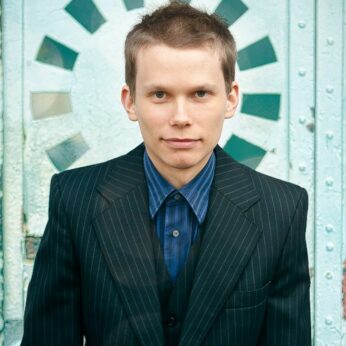Composer: Kalevi Aho (b. 1949)
Performance date: 06/07/2017
Venue: St. Brendan’s Church
Composition Year: 2013
Duration: 00:30:45
Recording Engineer: Richard McCullough, RTÉ lyric fm
Instrumentation Category:Quintet
Artists:
Joonas Ahonen -
[piano]
Peter Whelan -
[bassoon]
Hervé Joulain -
[horn]
Christoffer Sundqvist -
[clarinet]
Olivier Doise -
[oboe]

Finnish composer Kalevi Aho studied composition at the Sibelius Akatemia, Helsinki under Einojuhani Rautavaara and is considered by many to be the greatest Finnish composer since Jean Sibelius. His style of writing is engaging, full of musical imagination and he has an uncanny instinct for instrumental colours, resulting in works brimming with a sense of freshness and spontaneity.
This quintet for oboe, clarinet, bassoon, horn and piano – an unusual combination of instruments – was co-commissioned by the Sommersprossen Chamber Music Festival (SCMF) in Rottweil, and the DeFilharmonie Orchestra [Antwerp] in Autumn 2013. The initiative for the commission lies with oboist and artistic director of SCMF Ingo Goritzki, who was searching for a work that would couple well with Mozart’s Quintet K. 452 (of the same instrumentation), in concert. Composing for such an ensemble is no easy task and is a clear demonstration the composer’s talent. Aho manages to maintain the balance between the piano and the wind instruments, whilst simultaneously staying true to the integrity of each instrument’s unique tone quality. The final pro duct is a work of undeniable beauty, rich and sonorous in sound. Kvintetto was premiered at the SCMF in concert alongside Mozart K. 452 on 8 July 2014 and in Antwerp at the Orchestra’s chamber music series, on 5 October of the same year. The work belongs to a growing genre of commissions that are composed to be performed in concert with earlier works of the same instrumentation. Kvintetto is most commonly heard in concert, as it is today, alongside the Mozart quintet.
Kvintetto is written in four movements, the first of which is undeniably the most extensive of the work. It is of a lyrical and slightly melancholic character that leads towards an intense climax in the middle section. The second movement, a wild virtuosic toccata, has a demanding, impetuous and uninterrupted rhythmic energy consistently growing in the challenging piano part. The third movement – a silent and dreamy Nocturne of intrinsic beauty is followed by a fast, unruly, and rhythmical final movement. The final Burleske is possibly the most virtuosic and challenging part for the wind instrument, concluding a final section in which the composer indicates that the performers should accelerate to the maximum possible tempo.
– Norah O’Leary
Copyright © 2024 West Cork Music. All rights reserved.
Designed and developed by Matrix Internet